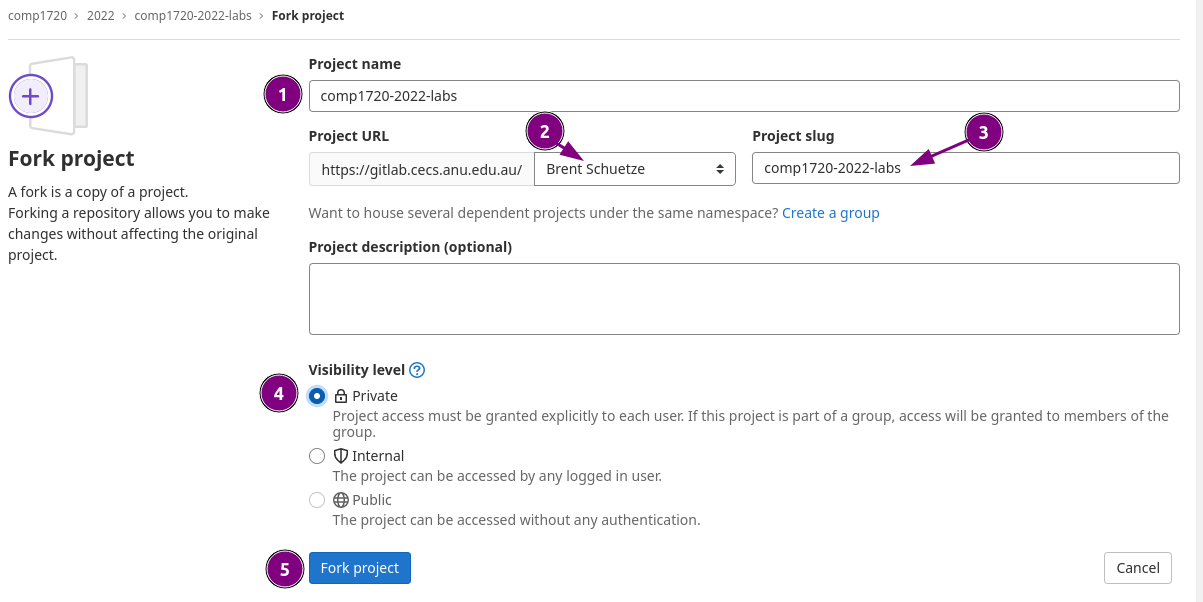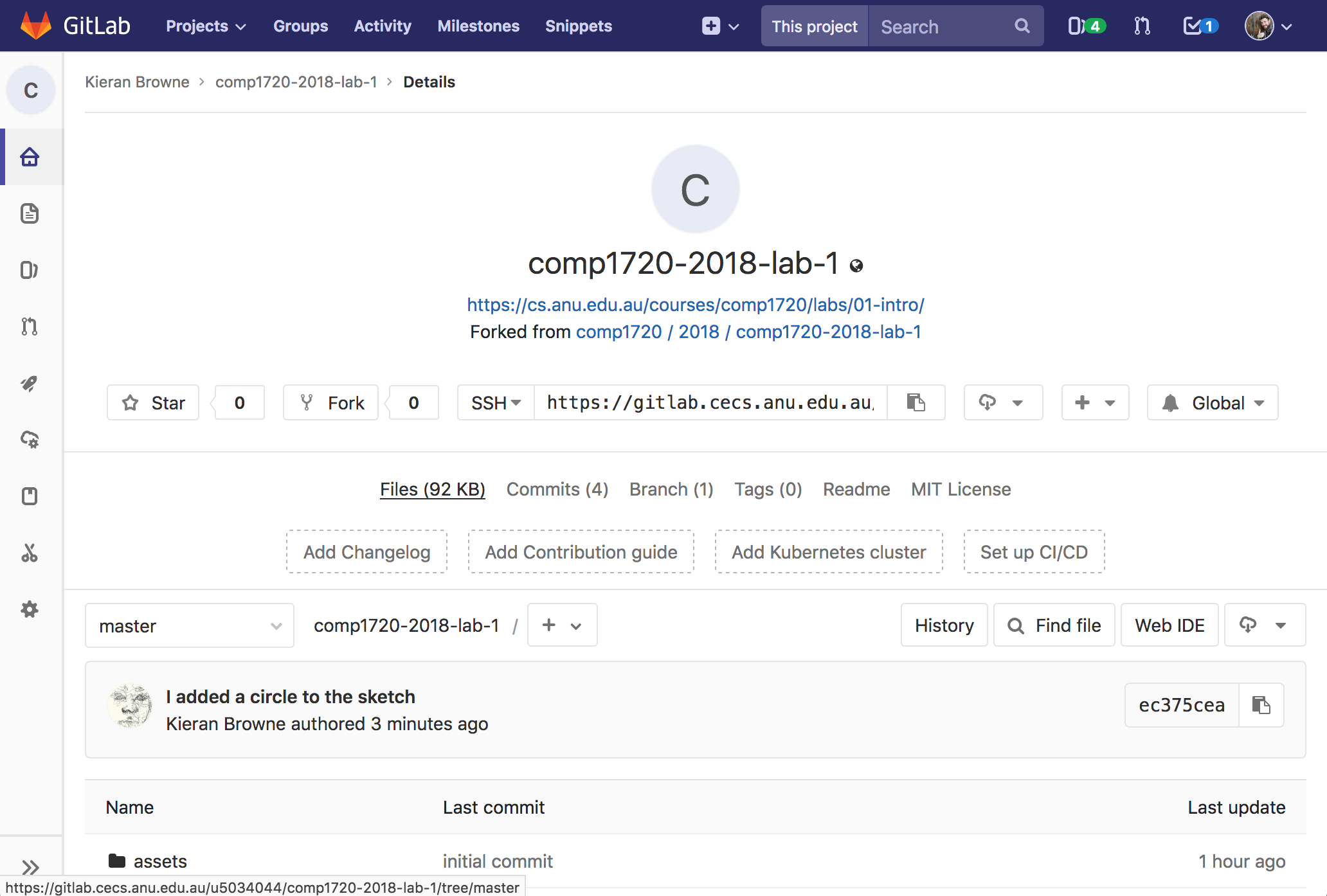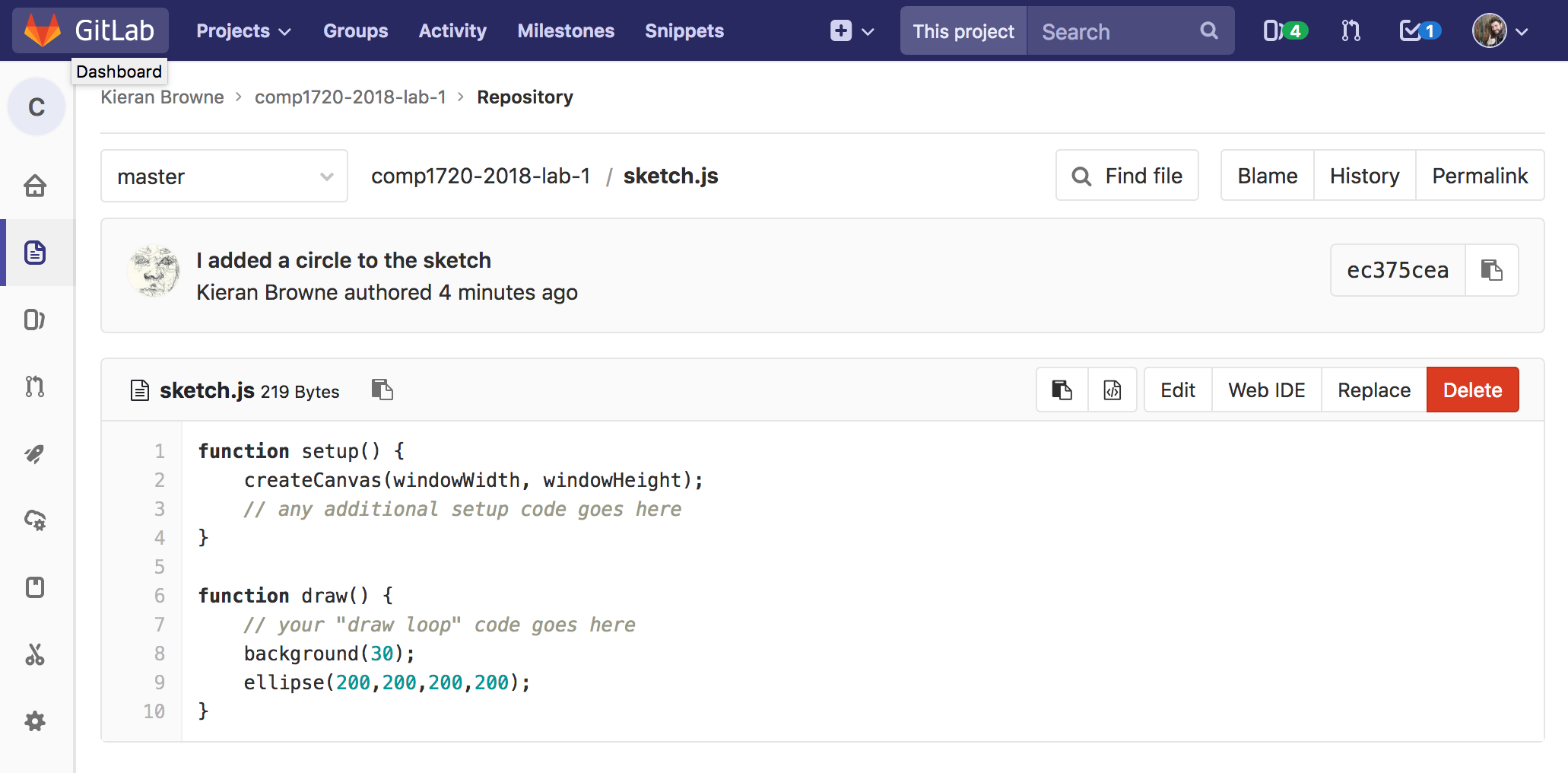Lab Tasks
If this is all very new and scary for you—that’s ok! There’s lots of support in this course to help you get your system organised and get started with coding. The main thing is to put in the effort to get started and then ask for help if you need it. Either in-person with your tutors, or on the forum.
This lab is a self-paced exercise. If you need help, attend a drop-in session in week 1 to ask a tutor (see ANU MyTimetable).
In this week’s lab you will:
-
meet the tools you’ll need in this course, including VSCode and the GitLab code server.
-
go through the steps you’ll need to submit assignments in this course
-
put a circle on the internet
Task 1: software setup
In this course you’ll write code using the VSCode text editor, run the code in the Chrome / Chromium web browser, and download/view/submit your lab & assignment code with git.
There’s a separate page dedicated to software setup, so if you’re on your own laptop you should head to the software setup page and follow the instructions.
You can install the software on your own machine and we also advise you to setup the software on the provided lab computers.
The lab machines have the software you’ll need pre-installed with one exception: you’ll need1 to install the COMP1720 VSCode extension (step 3 in the VSCode setup instructions).
Task 2: forking the lab template
From here, we’ll use a few git-specific terms, and in general we’ll explain everything along the way. If you’re confused, though, there’s a section on git help in the course FAQ or some extra installation help available in the software setup FAQ. In addition we also have some (old but still relevant) git screencasts which walk you through these steps.
Once you’ve got the software you need, you have to log in to the GitLab server at using your normal ANU credentials (uni ID and password) and bring up the lab repository. A repository (often abbreviated to “repo”) is basically just a box which stores a bunch of files and their history (the changes they’ve been through over time). Whenever you hear the word repo/repository, think “a directory of files which Git is keeping track of”.
You can read more about repos and forking on the dedicated SoCo Gitlab site.
This template is a starting point for everyone who wants to complete the labs, so before you can start working on it you need to create your own “copy”. This is called forking, and creates a new repo (your “fork”).
To fork the lab template, click the fork button on the GitLab page in your web browser (I’ve pointed to it below).

After clicking Fork, you will be presented with another page:

There are a few things to note here, and these will also be important when it comes to forking your assignment so make sure you follow / understand them.
- This is the project name, by default it will be the same as the repo that you’re forking from. Leave this as is (don’t change it!).
- This is the namespace that you’ll be forking the template to, make sure your name or uid is displayed here (you may only have that option anyway).
- This is the path for the fork, by default it will be the same as the repo that you’re forking from. Leave this as is (don’t change it!).
- This is the visibility level of your fork, it is important that you ensure that private is selected here. Once the fork is completed you can check that its private by looking at the icon next to the title, if its a little lock then you’re all good!
- This is the final step, click the Fork project button once you’ve checked and confirmed the above.
Once you’ve done that, you should see a page like the one below—you now have
your own fork (copy) of these files on the server, as indicated that it
shows your name in the top-left-hand corner (circled in green). The files are
exactly the same, but the repo is now attached to your GitLab account, rather
than the comp1720/2024 GitLab account, so you can change the files and push
things up to the GitLab server without messing up anyone else’s starting point.
This part of the process is covered in the forking screencast video.
Task 3: cloning the lab template
Your fork of the template repo is still on the GitLab server, though. To actually work on these files, you need to clone (download) this repo to the computer you’re working on.
Below are our steps, however general steps exist on the SoCo Gitlab website. Check them out if you want something more in-depth.
-
In VSCode, open the command palette (View > Command Palette, or
Ctrl+Shift+P/Cmd+Shift+Pon macOS) and a prompt will appear in the top. -
Type
git cloneand hit enter. A box will appear asking for the repo url. -
Back on gitlab, open your fork of the lab code. Directly under the page title there’s a box that looks like this (if it doesn’t say
HTTPSon the left hand side, click that box and select it. Now click on the right hand side box to copy the URL to your clipboard.)
-
Back in VSCode, paste the url into the prompt box and hit enter — making sure that the “Clone from URL” option is highlighted.

-
A window will open asking you where to save the files. If this is your own computer it might be a good idea to create a
comp1720folder and clone all your repositories there. If this is a lab computer, make sure you save this to your university homedrive (it’ll be calledu1234567). When you’ve found a good spot for you files hit Enter or click “Select Repository Location”. -
Now you’ll be asked to enter your username and password. This will be the same uid and password you used to log into GitLab (your anu login).
-
If you entered your uid and password correctly, a popup will appear in the bottom right of VSCode asking you to
Open RepositoryorAdd to Workspace. Today we’re going to chooseOpen Repository, but they have a similar effect.
Great job! Now lets make that circle.
This part of the process is covered in the cloning screencast video.
Task 4: making a circle
Now you’ve got the template files in VSCode you can get to work.
In the sidebar on the left you can see all the files in the template folder, including
a folder for each of the weeks / labs, for this one you’ll want to expand the lab-01 folder.
If you don’t like seeing all of the lab folders at once, you can also open the lab folder for that lab directly in VSCode. In general it shouldn’t matter, but if you have all of the labs open, make sure you’re working in the right lab!
Throughout the course we’ll explain what each of these files is for but for now
the one we care about is sketch.js (located in the lab-01 folder). Click on
that one and VSCode will open it up.
You’re getting close to creating the circle you’ve been thinking about all
along. In the draw function (immediately below // your "draw loop" code goes
here) add the following lines:
background(30);
ellipse(200,200,200,200);
Now save the file.
The final piece of the puzzle is to run/view the sketch. To do this, you need to start the live server:
- Open the command palette (
View > Command Palette) - Type “Open with live server”
- Hit Enter
Your default browser will open up and should show a white circle on a charcoal background.
As stated on the software setup page you should use Chrome / Chromium as your web browser for the course, and (for convenience) you could set it to be your default browser (since that’s what the live server extension will open the sketch in).
It might not look like much, but you’ve made your first p5 sketch, and you should take a moment to enjoy your success.

Task 5: committing & pushing the changes
Now that you’ve successfully completed today’s task of putting a circle on the internet it’s important that you save your work and push it up to GitLab. This process is important to learn because it’s the way you’ll submit all your assignments for this course!
The first thing to do is save your sketch.js the usual way (i.e. File > Save
or Ctrl-S/Cmd-S depending on your OS).
Now you want to upload your changes to the sketch.js file back to gitlab so
it’s safe and sound. This involves some more VSCode commands so open up the
command palette using View > Command Palette.
Type in git commit all and press enter. You’ll get a popup which says “There
are no staged changes to commit. Would you like to automatically stage all your
changes and commit them directly?”. Click yes.
Now you’ll see a popup asking for a “Commit Message”. Write a note about the changes you made (e.g. “I added a circle to the sketch”). This message is just so you can remember what this change was so write whatever makes sense to you.
In Git’s terminology, a commit is a snapshot of your code at a particular time that you can always return to. This means that if you break your code somehow you can always feel safe knowing you can just return to your last commit where everything was working. When working on assignments you’ll want to commit your code regularly just to be safe.
You can read more about committing here on the dedicated SoCo Gitlab site.
Now all you have to do is push (upload) these committed changes to GitLab with
the push command. Open up the command palette using View > Command Palette,
type git push and hit Enter. You might need to put your UID &
password in again at the push step. If you get an unauthorised message, try once
more and if it still doesn’t work seek help from a tutor or friend.
You can read more about pushing here on the dedicated SoCo Gitlab site.
If everything worked successfully, then when you refresh the GitLab project page
for your fork (i.e. https://gitlab.cecs.anu.edu.au/uXXXXXXX/comp1720-2024-labs)
you should see the first line of that commit message as shown:

And if you click on the sketch.js filename further down you should see the new
version with your ellipse line in there. Hooray!

This part of the process is covered in the committing and pushing screencast videos.
Task 6: putting your circle on the internet
It might have felt like your sketch was already on the internet when you were building it before because it was in your browser, but really it was only visible to you. By pushing your code to gitlab, your page was automatically published online.
You can check this worked by copying and pasting this link into your
browser and replace uXXXXXXX with your university ID.
https://comp1720.cecs.anu.edu.au/uXXXXXXX/comp1720-2024-labs/lab-01
If you can see your circle, great job, you’re done!
It’s good to get in the habit of checking the published version of your sketches because this is what your tutor will see when they mark your assignments.
If you can see your circle, great job, you’re done!
Extra Tasks
In every lab you will have some extra tasks available if you have finished your main lab tasks.
If you feel like you’re completely exhausted after completing the tasks above—that’s ok! We only expect you to complete the main tasks each week. Remember that this is just week 1, and we will explain everything in great detail over the next 12 weeks, it’s most important just to make a start early.
Setting up Git to work without a password
If you like, there are some extra steps you can take so that you don’t have to type in your uni ID and password every time, but it’s not essential and you can also add that stuff later.
(If you’re new to all this git stuff, probably just stick with the ID & password for now.)
Error and consoles
Now if you replace the code for drawing the circle in Task 4 to this:
ellipse(200,200,200 200);
What happens? The circle and your entire sketch are gone! Does this mean there is an error in you code? How can you find out?
Usually, we go to the chrome developer console for troubleshooting. It provides a detailed description of error in your code.
Changing the canvas size
What was the canvas size you used in Task 4? Is it a default one? How does it measure the width and height of a given P5 canvas? Give a try!
(Hint: Check out the reference of the createCanvas.)
Change the circle’s colour
Can you add some colour on your circle? You can start by using the fill (& color) function
fill(color(255, 204, 0)); //make my circle yellow
ellipse(200,200,200,200);
Don’t know what the three parameters in the function mean? It’s always good to check the reference!
Here are a few of other functions related to colour you can experiment: lerpColor(), colorMode(), alpha(), etc.
-
If you’re on your own machine or on a lab machine, you’ll only have to do this once—after that they’ll be saved to your home directory and will be automatically detected when you log back in. ↩